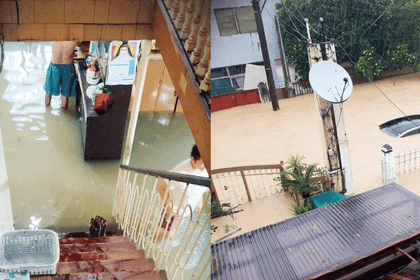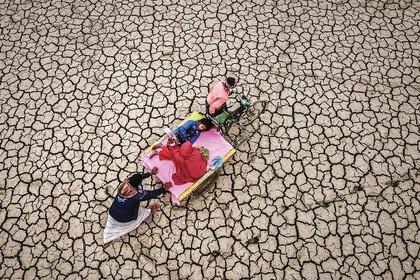
The health effects of climate change, explained
Climate change is a global health problem already impacting millions of people around the world. Here’s what you need to know.
El Niño conditions have ended, and we are now in a neutral phase with a likelihood of La Niña conditions emerging between September and November. The last El Niño event that began in July 2023 was marked by record-breaking temperatures, with 2023 becoming the hottest year on record. Find out about the health effects of El Niño and why preparedness is critical to mitigating its impact.
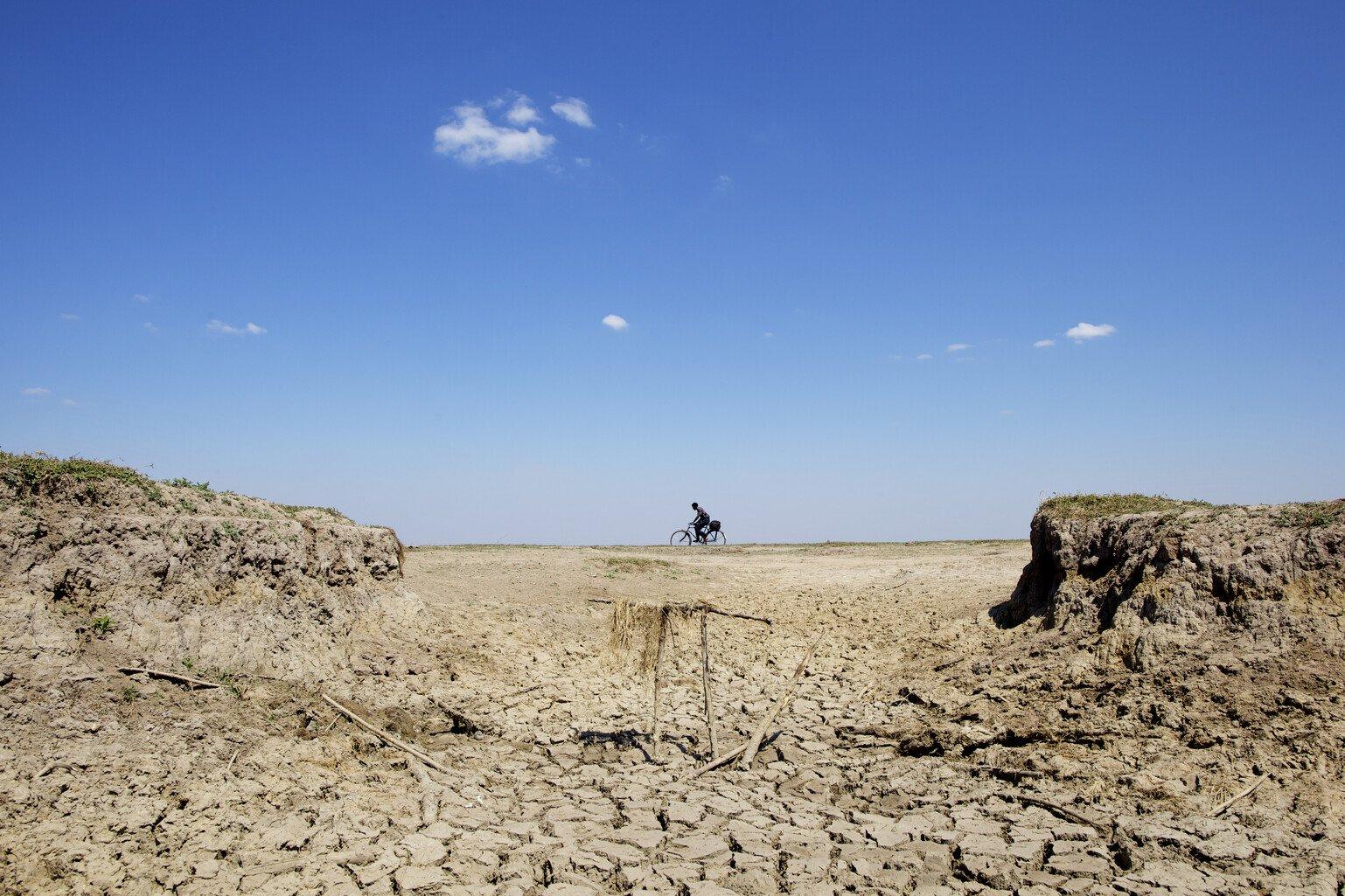
Kieran Dodds / Panos
Mud caused by flood waters becomes hard ground as waters recede during the dry season.

Digital Content and Social Media Producer, Wellcome

Digital Content and Social Media Producer, Wellcome
An El Niño, first observed by Peruvian fishermen in the 1600s, is one of the earth’s most significant climate phenomena.
During an El Niño, the surface waters in the central and eastern Pacific Ocean become significantly warmer than usual.
But the impacts of El Niño reach far beyond the Pacific, influencing weather systems worldwide.
One of the impacts of climate change is increasingly variable, unpredictable weather, the effects of which may intensify during an El Niño.
This last period of El Niño saw record-breaking global temperatures. In fact, 2023 was declared the hottest year since records began in 1850. This El Niño was also one of the five strongest on record.
We are currently in a period marked by neutral temperatures. After this, La Niña conditions could develop later in the year.
El Niño and La Niña are the warm and cool phases of a cyclical climate pattern — the El Niño-Southern Oscillation (ENSO).
ENSO is the most important natural climate phenomenon driving year-to-year variations in the seasonal climate in many parts of the world.
An El Niño state means warmer than usual sea-surface temperatures in the western Pacific – it has an irregular cycle of two to seven years.
La Niña state means colder than average sea-surface temperatures in the central and eastern Pacific Ocean. There is currently a 60% chance of La Niña occurring this year.
La Niña impacts each location differently and people usually experience the opposite of El Niño’s effects. Some parts of the world may have drier La Niña conditions that can lead to drought. Others might see wetter conditions and excessive rainfall.
But like El Niño, it has a range of serious health risks, such as a rise in vector-borne diseases like malaria because of unusually heavy rains in warm regions and respiratory diseases due to air pollution.
Both El Niño and La Niña phases usually last nine to 12 months but can last for multiple years.
Major El Niño events in the past 50 years have led to devastating floods, droughts, forest fires and coral bleaching. At least 26 El Niños were recorded in the 20th century.
El Niños vary in strength, with the 1997-98 El Niño the strongest ever recorded. Droughts struck Indonesia, Malaysia and the Philippines, while Peru faced heavy rain and floods.
The extreme weather associated with El Niño resulted in approximately 23,000 deaths worldwide.
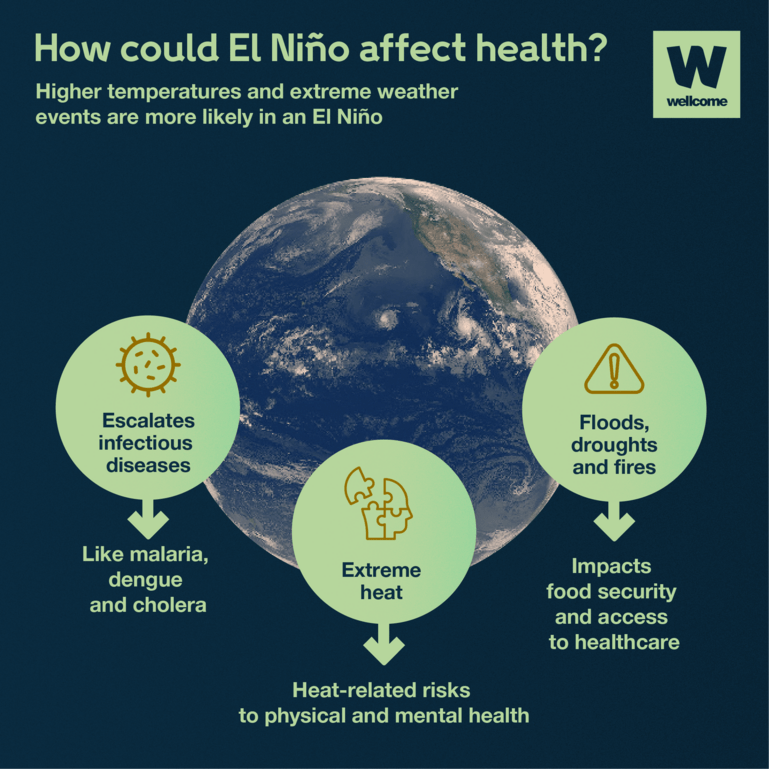
An overview of how El Niño could affect health.
Wellcome
The climate crisis is already a health crisis affecting millions. We know that global heating and extreme weather events, which are intensified in many regions by El Niño, have diverse impacts on our health, from infectious and respiratory disease escalation and malnutrition, to heat stress and mental illness.
We saw some of these health impacts during the 2023-2024 El Niño. For example, last year there were heat waves in southern Europe, more wildfires and related air pollution in Indonesia, and a dengue outbreak in Bangladesh.
There are many factors involved in climate-related events. This can make it hard to attribute specific health consequences to El Nino. However, we know that its impact on the environment has implications on health.

Climate change is a global health problem already impacting millions of people around the world. Here’s what you need to know.
In an El Niño, significant heat transfer from Pacific waters into the atmosphere drives short-term increases in temperatures, particularly around the tropics.
El Niño events are part of natural climate variability. But when combined with human driven climate change, an El Nino could temporarily push global temperatures beyond the critical threshold of 1.5 degrees Celsius.
The World Meteorological Organization confirmed that in 2023, the warmest year on record, the global average near-surface temperature reached 1.45 degrees Celsius above the pre-industrial baseline.
Rising temperatures directly contribute to heat-related deaths, with an estimated 30% of excess heat-related deaths attributed to climate change. This percentage is expected to rise as temperatures continue to climb.
Extreme heat can harm foetal development. For each degree Celsius increase in heat stress exposure, researchers found a 17% rise in foetal strain, measured by an elevated foetal heart rate and reduced blood flow through the umbilical cord.
El Niño conditions provide the perfect environment for many infectious diseases to expand their range.
Global heating means that more places are reaching suitable temperatures for disease transmission, and warming temperatures and shifts in precipitation during El Niño events create favourable conditions for pathogen survival and disease-carrying vectors like mosquitoes.
El Niño events escalate disease outbreaks and alter the spread of infections.
Past El Niños have driven a rise in malaria cases in Venezuela and Brazil, dengue outbreaks in the Pacific Islands, and cholera outbreaks in South India and Bangladesh.
During the 2023-2024 El Niño, there was also an increase in cholera cases in East Africa.
El Niño can make extreme weather events more likely in certain regions, including extreme heat, droughts, storms and flooding.
Flood-related health risks are complex and multifaceted, ranging from hypothermia, drowning, undernutrition and injuries to infectious disease escalation and mental health problems.
Flooding in the 2016 El Niño displaced over 150,000 people in Paraguay, Uruguay and Argentina. As a result, Paraguay declared a health alert for mosquito-borne diseases like dengue.
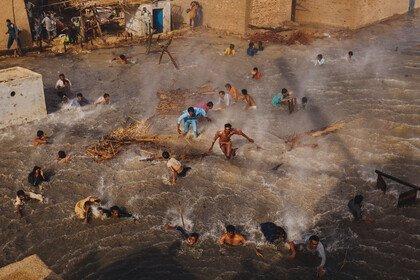
Climate change is making the world more susceptible to extreme weather events like flooding, which can impact human health
In the same year, wildfires contributed to as many as 100,000 fatalities, while an estimated 60 million people across Africa, Asia, the Pacific and Latin America required food assistance.
With food systems already vulnerable to extreme weather, we are likely to see higher malnutrition rates due to crop failure and increased food insecurity.
El Niño events have severe, long-lasting impacts on country-level economic growth, particularly in the hardest-hit nations.
We know that climate change adversely impacts mental health in different ways.
During heatwaves, suicide rates, hospitalisations for psychiatric disorders, and emergency psychiatric visits have been shown to increase.
Global heating means people taking medications that disrupt the body’s ability to regulate temperature are particularly vulnerable in high temperatures.
Meanwhile, hospitalisations for climate-sensitive infectious diseases and coping with the long-term consequences of severe infections both compromise mental health.
El Niño could intensify all these impacts.
Climate change is a global health crisis, and that includes mental health. Find out how it’s impacting our mental health and what can be done to prevent and manage it.
The severity and nature of El Niño’s impacts on infectious disease spread, malnutrition, and respiratory and mental health varies across different regions.
The most affected areas include:
Latin America (such as Peru, Venezuela and the Brazilian Amazon)
Southeast Asia (the Philippines, Indonesia and Malaysia)
West Africa
the Horn of Africa
Australia
Pacific Islands.
These regions often struggle to cope with climate shocks, with those in low- and middle-income countries disproportionately affected. Coastal communities also bear a heavier burden due to an increased likelihood of storm-driven coastal flooding and erosion.
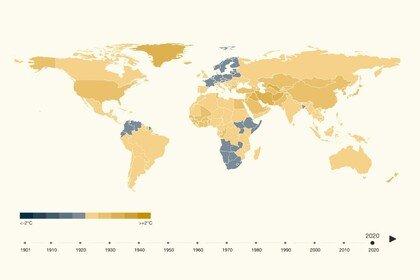
Data is a powerful tool for understanding the health effects of climate change. That’s why we’ve mapped 120 years of global climate and health data to illustrate how climate hazards have changed over time. What's crucial now is improving the data used by health workers and policymakers to protect communities most at risk.
The human health consequences for some of the most vulnerable populations in the world will be catastrophic.
However, there is still time to act to limit the health effects.
Significant progress has been made in accurately predicting El Niño events and their effects several months in advance.
This increased lead time is an invaluable opportunity for societies worldwide to enhance preparedness measures, ranging from emergency services readiness to strategic agricultural planning.
We are funding research to enhance our understanding of climate-related health impacts and develop strategies for adaptation and mitigation. This includes:
This research is crucial for preparing for and mitigating the health impacts of climate change and El Niño events.
Alongside research efforts, we need political leadership at all levels to ensure the health impacts of El Niño are prominent on the global agenda. This is critical to drive action.
Wellcome is collaborating with governments, policymakers and stakeholders to raise awareness about the health risks associated with an El Niño event.
We want to see more collaborative partnerships at all levels: global, regional, and local, across El Niño-affected countries and between academia and research institutions, for example, to better understand the health risks and identify solutions.
We must recognise the complex and multifaceted nature of the health impacts of an El Niño. Strategies should focus on building resilience, prioritising region-specific interventions, particularly among vulnerable populations.
By drawing on knowledge of the interplay between El Niño, climate change and health, we can develop preparedness measures and adaptation tools that address the unique challenges faced by different regions and mitigate the potential health impacts of El Niño.
We’re funding vital research into the impact climate change has on human health around the world, at national, regional and global levels. Explore our current funding call:
Advancing climate mitigation solutions with health co-benefits in low- and middle-income countries
Alan Dangour, Director of Climate and Health, shares his vision for our Climate and Health programme.
